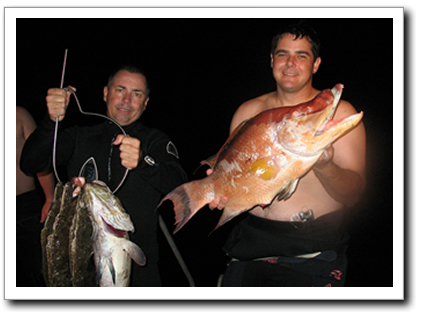
It's different down there at night. The first time you descend into the darkness you'll realize that it's almost a completely different world at night. Even though it sounds a little scary, you'll find that there's nothing to worry about and that night diving is usually much more relaxing that diving during the day. What Do You See At Night? The reef comes alive with a whole different cast of characters at night. Most of the fish you see during the day hide away to sleep at night and many that can't be found during the day can be seen all over the reef. Night-time is the best time to see crabs, lobsters, and shrimp going about their business. Octopi come out and swim freely alongside hunting sharks and barracuda creating an amazing show. But it doesn't stop there, one of the most spectacular parts of night diving is watching the coral feeding. Coral blooms after dark, absorbing nutrients from the water around it and looks truly beautiful. Of course, an incredible occurrence that can only be seen at night with all lights turned off is bioluminescence, amazing organisms that glow in the dark! Where to Night Dive There are a few basic considerations for choosing a dive site for a night dive. It's best to dive somewhere you've already dived during the day, you wouldn't want to get lost in the dark! It's also important to choose a site that isn't very deep (preferably 60 feet / 18 meters at the most) and doesn't require you to swim too far. It's also best not to dive in difficult conditions. Before the Dive It's advisable not use new gear for the first time at night as it's important to know how it operates and feel comfortable with it first. The same goes for a dive buddy. Because of the need to stick closer together at night and the increased difficulty signaling each other it's best to dive with a buddy you already know and feel comfortable with. You'll want to set up your equipment in a well lit area. It may sound basic, but many divers are used to setting up their gear on the boat on the way to the site during the day and find that there may not be enough light to do this at night. You should also check both your primary and backup dive light to ensure that they're working properly before leaving shore. Entering the Water It's important to perform your buddy check before leaving the boat or shore. Make sure your dive light is attached to your wrist or a lanyard and turn it on before entering the water. Turning your light on before entering the water, and off after leaving the water is a very good habit to get into as it makes it much easier to find the light in the event that you drop it into the water. Make sure that you look down into the water, using you dive light, to check for other divers or obstacles before you enter the water. Descending There are a few differences when descending at night. You should stick close to your buddy, ideally facing each other. It is best to descend feet first in a vertical position to protect from any obstacles which may be beneath you. You should also shine your light downward and watch carefully where you're going. Just like during the day, be careful not to hit the bottom so that you avoid stirring up sand or damaging coral. During the Dive The best way to enjoy a night dive is slowly and steadily. There are so many little things to see, you should take your time and have a nice close look at everything. You'll be delighted to find that with the additional light provided by your dive light the coral will be even more colorful and vibrant than during the day. Due to the slow and relaxed pace of night diving most people find night diving to be very relaxing. It's important to be aware of where you're shining your light. Avoid shining your light at other divers or directly into the eyes of fish as this can startle them, both the divers and the fish! Signals To signal at night it's necessary to do things a little differently. To signal OK you should either make the OK sign with one hand while shining your light on it or if the recipient is a little further away you can draw a circle in front of you with your light. To attract another diver's attention you can flash the beam of your light across theirs. If you're having trouble attracting their attention you can quickly flash your light on their chest. Most gauges will glow if a light is held to them for five or more seconds. This is a good way of showing your air gauge to your buddy or instructor. Ascending Ascent is the same as during the day with the added need to stay close to your buddy and shine your light upwards to be able to see where you're going. Back on the Surface The best way to signal the boat, shore, or other divers is to either shine your dive light on yourself to make yourself visible in the water or to signal OK by drawing a circle in front of you, just as you did underwater. Remember to keep your light on until you're safely back on the boat or shore. Night Diving Courses It's possible to do a night dive as part of the Advanced Open Water course and it's also possible to do a more detailed Night Diving specialty course. While there is no formal qualification for night diving, it is recommended, and may be insisted upon by some dive operators, that you complete your first night dive under the supervision of a dive instructor.
|
Boat Trips | Night Dives | Spring Dives | Commercial Diving | Travel with Sea Dogs
| Home | SCUBA Diving | SCUBA Instruction | SCUBA Equipment | Rates | FAQs | Reefs & Wrecks | Spring Diving | Lobster Hunting | Spearfishing | Contact | Travel with Sea Dogs | ©2009 Sea Dogs Dive Center • New Smyrna Beach, Florida • 386-424-1644 |

 Night Dives
Night Dives 